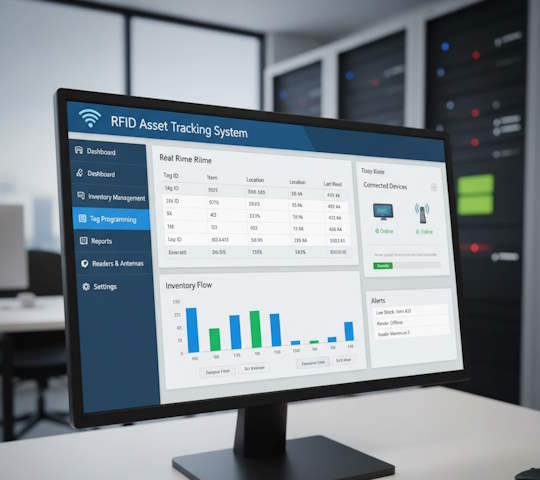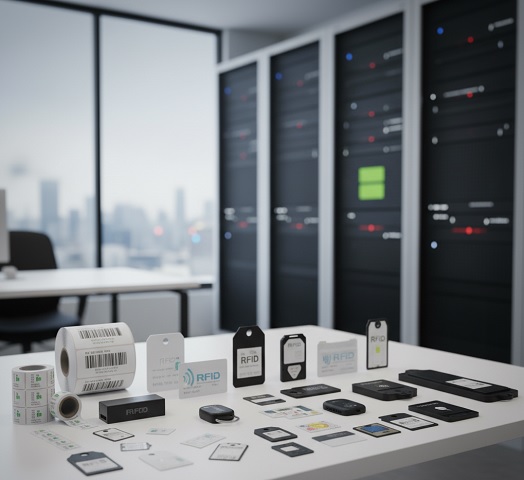RFID in Healthcare: Digital Transformation of Asset and Medication Management
Introduction
Hospitals can lose 10–30% of medical supplies annually due to inventory errors and leakage, impacting budgets and patient safety. Global reports and deployments show that GS1/ISO‑aligned RFID reduces losses by up to 20–30%, increases equipment availability to ~99%, and speeds medication dispensing by ~15–25%. This guide explains how to run a measurable RFID pilot for Ukrainian healthcare providers and achieve verifiable ROI.
Problems and key KPIs
-
Core issues: manual inventory, barcode limits, dispensing errors, equipment downtime, cold chain breaches.
-
KPIs: inventory loss rate; time to locate equipment; device availability; medication dispensing accuracy; temperature compliance.
Technologies, tags and standards
-
Tag types:
-
passive UHF (860–960 MHz) for bulk inventory;
-
active tags / RTLS for real‑time location;
-
temperature‑logging tags for cold chain;
-
tamper‑evident e‑seals for container integrity.
-
-
Standards: GS1 identifiers; ISO/IEC 18000‑6 (UHF); ISO 13485 / IEC 60601 for devices; GDPR / HIPAA for privacy; WHO and FDA guidance for supply chains.
-
Interoperability: use GS1 GTIN/GLN/SSCC schemes and ISO‑compliant tags; secure APIs for EMR/HIS integration.
Comparison table: manual vs barcode vs RFID
| Method | Accuracy | Speed | Automation | TCO (indicative) | Note |
|---|---|---|---|---|---|
| Manual | <90% | Low | No | High | Human dependent |
| Barcode | 90–97% | Medium | Partially | Medium | Requires line of sight |
| RFID (passive UHF) | 98–99.9% | High | High | Mid→Low | Bulk scanning |
| RTLS / Active | 95–99% (location) | High | High | High | Real‑time positioning |
Use cases and scenarios
-
Pharmacy/stockroom: automated stock counts, expiry control, FIFO for high‑value meds.
-
Depots/ORs: rapid locate of kits and instruments.
-
Equipment management: track monitors, pumps, portable devices.
-
Cold chain: continuous temperature monitoring and traceability for vaccines.
-
Patient ID: RFID wristbands linked to EMR to prevent errors.
Financial and operational impact (ROI)
-
ROI methodology: inputs — SKU count, avg unit cost, current loss rate, labor cost, CAPEX/OPEX.
-
Sample calculation (illustrative):
-
5,000 SKUs; annual inventory value $3,333,333; current losses 15% → $500,000/yr.
-
Post‑RFID losses 5% → $166,667/yr. Savings = $333,333/yr.
-
Pilot CAPEX $100,000; OPEX $50,000/yr → payback in ~3–12 months depending on scope.
-
-
Expected outcomes: loss reduction 15–30%; search time ↓50–70%; device availability 98–99%.
International case summaries (E‑E‑A‑T)
-
HIMSS (US) — equipment control cases: availability up to 99%, search time ↓60%.
-
GS1‑led European rollouts — medication loss ↓20–30%, improved cold chain traceability.
-
Asian hospital networks — RTLS + RFID for staff routing and emergency response improvements.
Pilot roadmap (60–120 days)
-
Needs assessment and KPI definition (2 weeks).
-
Select pilot area: pharmacy, depot or OR (1 week).
-
Tag and architecture selection (passive UHF vs RTLS) (1 week).
-
Reader installation and EMR/HIS/WMS integration via APIs (2 weeks).
-
Testing and metrics collection (throughput, read rate, FP/FN) (30–120 days).
-
Analysis and scale‑out plan.
Privacy and security
-
Minimize personal data on tags; encrypt communications; role‑based access control; GDPR/HIPAA compliance.
FAQ
-
When will the pilot show results?
-
Initial operational improvements seen in 30–60 days; stable KPI changes in 3–6 months.
-
-
Which tags for vaccines?
-
Temperature‑logging RFID tags with GS1 IDs.
-
-
How to integrate with EMR?
-
Via API/HL7/FHIR and middleware; validate on pilot.
-
-
What is pilot cost?
-
Typical pilot for a medium hospital: $20k–$150k.
-
-
What to include in tender docs?
-
GS1 identifiers, ISO/IEC 18000‑6 compliance, tag datasheets, test reports.
-
H2 Conclusion and CTA
RFID delivers measurable reductions in inventory loss, faster workflows, and improved patient safety when implemented to GS1/ISO standards with privacy safeguards. CTA: Request a readiness audit for an RFID pilot; receive an ROI calculation and a 90‑day pilot plan. (Button: Request audit & ROI)
H2 Sources (mandatory links)
-
World Health Organization — Digital Health resources: https://www.who.int/health-topics/digital-health
-
GS1 Healthcare: https://www.gs1.org/industries/healthcare
-
U.S. Food and Drug Administration (FDA) — Medical Devices: https://www.fda.gov/medical-devices
-
HIMSS — resources on RFID/RTLS: https://www.himss.org/resources
-
Impinj Support & Monza R6‑P brief: https://support.impinj.com
-
McKinsey healthcare insights: https://www.mckinsey.com/industries/healthcare-systems-and-services/our-insights




